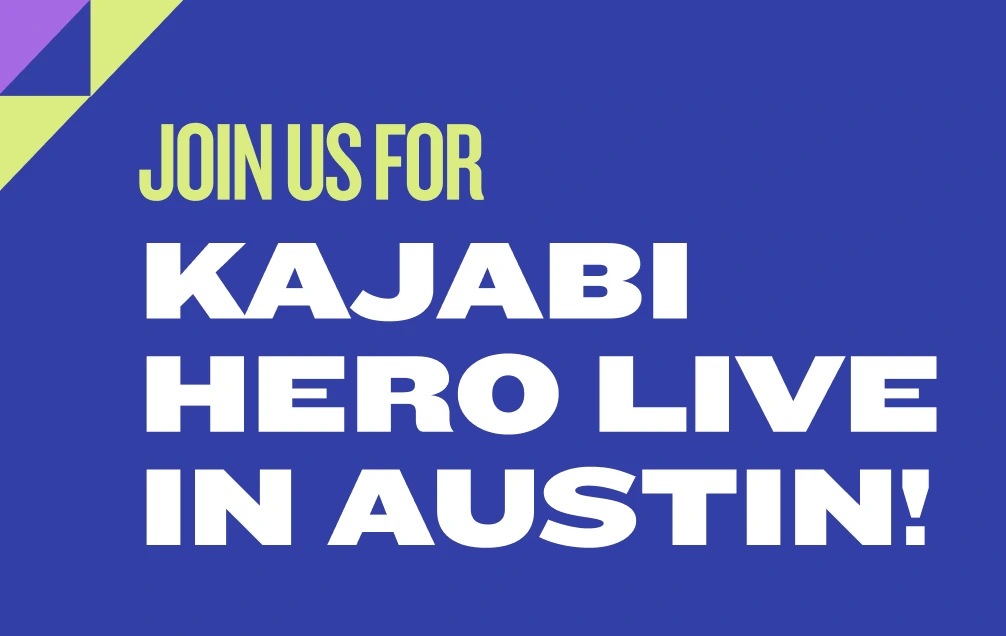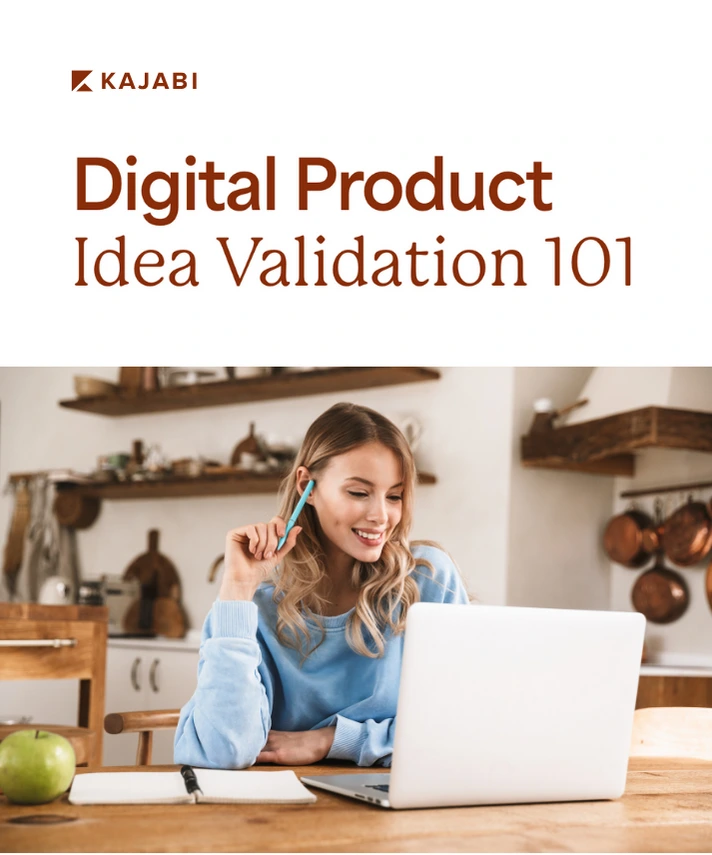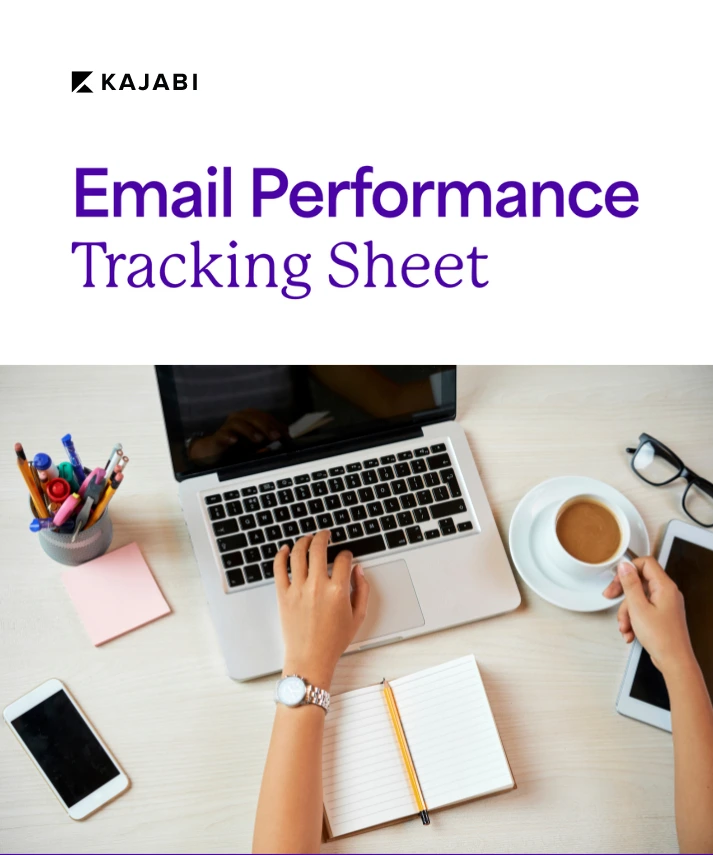
How to write a follow-up email that converts leads into customers
Get free expert insights and tips to grow your knowledge business sent right to your inbox.
Learning how to write a follow-up email can help you convert and retain more customers. That’s the main reason you create online courses, right? You want to make money and reach more people.
As of 2017, businesses collectively send more than 225 billion emails per day. Unfortunately, consumers only open about one-third of the emails they receive.
Not only are you competing against the other businesses that want to reach your target audience, but there’s a good chance that you have less-than-stellar email open rates.
Follow-up emails help guard against both problems:
Your target audience will get used to seeing your name in their inbox, which makes them more likely to open your emails; and if your intended recipient didn’t open a prior email, you might have better luck with the follow-up.
But when and why should you send follow-up emails? And what are the best practices for increasing conversion rates, inspiring click-throughs to your website, and retaining your positive brand image?
Those are the questions we’ll explore today.
What Is a Follow-Up Email?

A follow-up email is an email that you send to leads, prospects, or customers after a specific interaction. For instance, if someone signs up for your email list, you can send both a confirmation email and a follow-up email.
The confirmation simply reaffirms that the subscriber wants to hear from you. In your follow-up email, you can introduce your business to the prospect, direct the subscriber to your sales pages, and let the subscriber know what they should expect from future emails.
But we’ll dive deeper into the content of your follow-up emails later. For now, just assume that any email you send after an interaction with a prospective or current customer qualifies as a follow-up.
You can either send follow-up emails manually or automatically — though we recommend the latter. Instead of spending all day typing emails to individual consumers, you can automate the process through Kajabi’s tools and integrations. You’ll save time that would be better spent creating more online courses.
Why Should You Follow Up With Customers and Prospects?
As we mentioned earlier, consumers get lots of emails — many of them from entrepreneurs like yourself. They’re extremely busy, so they’re just as likely to delete your emails unread as to open them and click through to your website.
That’s a big obstacle to tear down.
Follow-up emails reintroduce the consumer to your brand and demonstrate consistency. They provide a reason for the consumer to open the email and engage with its contents.
Have you ever gotten a jingle stuck in your head after seeing the same commercial three times during a night of television binge-watching? That’s exactly what the brand wanted. Repeated exposure to a brand helps keep that business in the consumer’s mind.
You don’t have to write a jingle or pay for a television commercial spot, though. Email marketing can prove just as effective as long as you keep in touch with your subscribers and customers.
How Can You Write Follow-Up Emails That Convert?
We’re passionate about email marketing here at Kajabi, but we want to stress that you can fail if you’re not familiar with the industry best practices for follow-up emails. Making mistakes during this process can result in reduced conversions.
Start by creating a template. This is a standard email that you’ll send out to customers after a specific interaction, such as subscribing to your email list, buying one of your online courses, or entering a contest or giveaway.
The template should include several specific features that are designed to funnel your subscribers toward a subsequent conversion.
Remember: conversions aren’t the same as customers. Just because someone subscribes to your email list doesn’t mean that he or she will ever buy one of your digital products.
You need to encourage your subscribers to convert one more time — from prospect to customer — and follow-up emails can help you do that.
Grab Attention With Your Subject Line
Let’s start with your subject line. In a 2017 article, HubSpot contributor Amanda Zantal-Wiener outlined 16 excellent email subject lines. One of them — from an email created by King Arthur Flour — offers an excellent template for a specific follow-up email:
“The timer’s going off on your cart!”
This subject line gets delivered to customers who have abandoned their shopping carts. King Arthur Flour wants its customers to know that, if they don’t return to their carts, they will be automatically emptied.
That’s a great way to reel in customers who might otherwise be lost. It’s a courteous reminder to return to the website and take advantage of the products available.
You can use this strategy for any type of follow-up email. You want to create a sense of urgency, make your email as timely as possible, personalize the correspondence, and inspire curiosity about the email’s contents.
Understand What You Want to Achieve
Follow-up emails don’t work unless you have a specific goal in mind. Just saying, “Hey, I’m checking in,” won’t work because the customer doesn’t understand the point of the message.
You need to get more specific.
Let’s go back to the email marketing example. A customer has just subscribed to your email list, which means that he or she is already brand aware. It’s not yet time for a hard sales pitch. Instead, you want to gently remind the customer about your brand and its offerings.
Maybe your follow-up email could include a list of links to your best blog posts. Encourage the customer to check them out to get free information about your industry.
In this case, your goal is to immerse the customer more fully in your brand. As the consumer peruses your content, he or she makes an emotional and psychological connection with the material.
Greet the Recipient Correctly
Entrepreneurs get this wrong all the time. Improper salutations can kill your conversion rates and result in disgruntled prospects.
Using the recipient’s name is often a nice touch. We’ll talk more about personalization later, though.
The important thing is to include some type of salutation. It could be “Hi,” “Hello,” or some variation, but it needs to be included in the first line of your email.
In other words, don’t jump right into the content.
If you’re using the recipient’s name, the word “Dear” followed by the name still stands as a true classic. It’s a little more formal than “Hi” and it communicates respect.
However, you have to know your audience. Maybe you market to younger, less formal consumers. In that case, using a formal salutation might not connect with your target audience.
Get Right to the Point
While you need a salutation in a follow-up email, you don’t need a lengthy introduction. You want to show that you’re not interested in wasting your prospects’ time, so keep the email short and sweet.
The actual text should relate to the last interaction you had with your customer, whether it was a contest entry, an email opt-in, or a purchase of your online course. Don’t leave the recipient wondering why you’re reaching out.
Add Some Personalization
We already talked about mentioning the recipient’s name in the salutation, but personalization goes beyond that:
- Speak in the second person point of view: Talk directly to the reader (using you and your, for instance) so that the email sounds like a personal communication between friends.
- Mention the last interaction: You might say something along the lines of, “Thank you for your recent purchase of [Course Name].”
- Invite feedback: Ask the recipient to reply with any suggestions, concerns, or other feedback. Show that you’re willing to listen.
Personalized content gets read far more often than impersonal content. You want to establish a connection with the reader so that he or she anxiously awaits your next communication.
Avoid Tangents
Consumers get annoyed when they can’t follow an email’s train of thought. Furthermore, spinning your prose off on wild tangents will distract the reader from your call to action and the goal you’ve set for this email campaign.
Keep your follow-up email focused on what you want the recipient to do next. Leave the fluff and filler at the curb so you don’t annoy your subscribers and customers.
This is where a good copy edit comes in handy. After you write an email or an email template, let it sit for a day or two. Then go back to it and try to read it like a consumer would. Can you cut words, sentences, or even whole paragraphs without diluting your message?
If so, do it.
Wrap Up With a Call to Action
The call to action (CTA) is the single most important part of your follow-up email. When done correctly, a CTA will convince your prospect to convert on your offer, whether it’s a discount on an online course or an invitation to connect on social media.
Make the CTA as obvious as possible in the email. If you’re sending plain-text emails, format the font in bold and use a distinct color for the link. You can even change the color of the text if you wish.
For HTML emails, you can get a little more creative. Include a button or some other graphic that helps the CTA stand out.
When Should You Follow Up?
Now that we’ve covered the whys and hows of follow-up emails, let’s discuss the best time to send these messages. Obviously, if you’re sending them too often, you’ll simply annoy the recipient.
That’s the last impression you want to make on your customers.
Different types of follow-ups demand different timelines. If you’re following up after a purchase, you might wait just 12 to 24 hours. For follow-ups after email subscriptions, consider waiting two or three days after you send a confirmation email.
For all other follow-ups, consider letting a week pass before you send them. You’ll give the consumer the impression that you’re not desperate for his or her business.
Over time, track your follow-up emails in particular. You’ll start to see patterns in the data. For instance, if one type of follow-up doesn’t seem to work, maybe you need to send it sooner or later. Continue testing different strategies until you find one that works for you.
Opportunities for Follow-Up Emails
Getting the timing right, knowing how to write follow-up emails, and understanding the best practices are all essential elements of your marketing campaign. However, you also need to know what interactions or events should trigger follow-up emails.
It’s not an exact science. However, following marketing best practices can increase your conversion rates and make your emails more effective.
You have several chances to send follow-up emails to your online course customers and prospects. Each interaction requires a different type of email, so we’re going to cover each one in more detail.
Connect With Prospects Who Sign Up for Free Trials
Maybe you offer a free trial (or a free mini-course) to get your prospects immersed in your digital products. You might even have a membership site that includes a brief free trial.
Following up with customers who have taken advantage of a free trial is essential. You want to check in with them, find out how they feel about your content, and invite them to upgrade to a premium membership or purchase.
Send your follow-up email on the day that the free trial ends. Use excitement and urgency in your follow-up email. You might offer a one-month or one-time discount, for example, that expires in 48 hours.
Most importantly, stress the benefits that the recipient will enjoy after becoming a paid customer.
Catch Up After Lead Magnet Opt-Ins
We love using lead magnets to convert website visitors into email subscribers. Lead magnets allow you to collect more contact information, establish authority with your audience, and gain the opportunity to convert prospects into customers.
When someone opts in to your email campaign, send a follow-up email two or three days after you send the confirmation email. Remind the subscriber what he or she should expect from your email campaign, such as discount codes, coupons, educational content, blog post roundups, and more.
Don’t be afraid to get specific. For instance, you might mention that you send emails every Monday afternoon at 4 p.m.
Maximize Customer Retention With Post-Sale Follow-Up Emails

We’ve mentioned before on the Kajabi blog that it’s easier and less expensive to bring an existing customer back for a purchase than to convince a stranger to buy the first product. It’s called customer retention and it increases your customer’s lifetime value.
After your customer purchases one of your products, send a follow-up email a day or two later. Mention the other products you have available and invite recipients to check them out. You can even provide a brief (one- or two-sentence) overview of each.
Customize this follow-up email even further by only mentioning your courses and other products that relate to the product your customer has already bought. It’s a form of personalization that increases conversions and shows the customer that you won’t waste his or her time with irrelevant sales pitches.
Get in Touch With People Who Enter Contests and Giveaways
All forms of gamification can help boost conversion rates. People love playing games and they love winning prizes. If you run a contest or giveaway, make sure to follow up with all participants or entrants to let them know about your online courses.
If someone has entered a contest to win free access to your online course, he or she is obviously interested in the product. Otherwise, that person wouldn’t have wasted time filling out the entry form or taking part in the contest.
You can trust that many of those consumers will want to buy your course if they don’t win. Take advantage by thanking the entrants for taking part in the contest and inviting them to visit your sales page.
Follow Up With Direct Email Outreach
If you’ve sent cold emails to prospective customers, you need to follow up. Since the recipient likely doesn’t have any brand awareness yet, your email might have gotten deleted.
Unlike other email marketing campaigns, don’t automate this one. Instead, you want to send a dedicated, personalized email that addresses the recipient by name and includes other personal details.
Why did you reach out to this person? How can he or she gain specific benefits from your online course?
Keep it short and sweet, but fill it with personalized references.
Ask Customers to Review Your Course
Online reviews provide social proof that your online courses and other digital products have helped people achieve goals and solve problems. The more reviews you get, the more visible you become in search engines. Plus, people who visit your site will see testimonials right away.
Consider directing your customers to a specific page — either on your own site or on a review site like Yelp — and asking them to write an honest review of the product they purchased. Wait a reasonable amount of time so you know they completed the course.
Thank Customers Who Have Mentioned You Online
Have you set up a Google Alert for your name and your business’s name? If not, finish reading this article and then set up Google Alerts right away.
You’ll get an email whenever you’re mentioned online, whether it’s in a blog post or on social media. If someone speaks highly of you, consider sending him or her an email (or a social media direct message) to thank that person.
It’s a nice, personal touch that can improve your brand image and help you retain customers. You can even direct the person to new content that you’ve posted or new online courses that you’ve created. Maybe he or she will mention you again.
Schedule a Sales Call
If you sell expensive online courses, you might have to move out of the online marketing game and into a more traditional sales role. Setting up a time to talk to a prospective customer can help you close the sale faster and more efficiently.
This follow-up email doesn’t have to be long. It could look something like this:
“Hi [Customer Name], I’d love to talk with you more about [Name of Online Course]. I think you’d be a great fit because [reason]. Can we set up a time to chat on the phone for five minutes? Just let me know what time works for you.”
You can also offer several times that you have available and invite the prospect to pick one.
Most of the time, you’ll send a sales call follow-up after you’ve already reached out once. This is your second bite at the apple, so make it count. The more you know your audience, the better you can craft this type of follow-up email.
Check in After an In-Person Meeting
Maybe you’ve encountered a prospect at a trade show or even at the coffee shop down the street. If you snagged that person’s email address, send a follow-up email to remind him or her of what you do and to invite the recipient to check out your digital products.
Remind the customer about where and how you met. It should include details, including your name and your business name as well as the event where you met. You want the recipient to remember you and immediately associate the email with your brand.
Get in Touch With Someone After a Referral
Did a customer refer someone else to your business? Get in touch with that person and thank them for sending business your way.
It’s not just a good customer-retention tool. It’s also a way to build brand loyalty and respect. Even better, that person might refer other business to you in the future since you bothered to reach out with a follow-up email.
Reconnect With Dormant Customers
When a customer has bought from you in the past but remained dormant for several months, consider sending a follow-up email. Let him or her know about any new courses or other digital products that you’ve released and invite that person to check them out.
Often, people forget about businesses after going through an online course or buying an e-book. They need a reminder that you still exist.
Don’t get too heavy-handed with this type of follow-up email. Just include a few sentences about your latest product offerings. At the end, you can ask if they still want to hear from you. If not, you can remove them from your subscriber list.
Urge Customers to Check out Upcoming Courses
Every time you release a new course, send a follow-up email to people who have bought from you in the past. This is why email list segmentation has become so critical for online marketing success.
This follow-up email should remind the customer that he or she enjoyed your last product. Include lots of benefits about the new online course to entice the customer to check it out.
Send Better Follow-Up Emails Through Kajabi
We’ve made email marketing as simple as it can get with the Kajabi platform.
- Send automated emails, including follow-up email templates
- Segment email lists
- Set email triggers
- So much more
Start by creating the templates we discussed earlier. You’ll want something fresh and unique for each follow-up email you send. Make sure you’re not sending the same email to customers over and over again.
Next, decide what will trigger a follow-up email, such as an email opt-in or a purchase on your Kajabi website. Set up your emails to get triggered automatically when one of these events takes place.
Over time, you’ll figure out what language, graphics, CTAs, and other elements work best in your follow-up email. It can vary widely from one industry to another. The important things are to stay consistent and to continually test new messaging.
Conclusion
Sending follow-up emails will only take a few minutes of your time, especially if you use an automated email marketing strategy. The ROI can prove enormous if you’re committed to following up with every single lead.
However, you need a reason to follow up. Otherwise, your audience will just assume that you’re spamming them.
That’s why we provided you with a list of reasons to send follow-up emails. Take advantage of each one that applies to your business model so you don’t let leads slip through the cracks of your marketing strategy.
Just remember that people are busy. Don’t take up too much of their time with a long, rambling email. Get right to the point, include a CTA, and — most importantly — thank the customer for their purchase or time.
If you’re not sure how to write follow-up emails, follow the above step-by-step instructions to make your emails more effective. You can take advantage of the tools Kajabi provides to increase your chances of success.
Do you send follow-up emails to your leads and customers? What about drip campaigns? What tactics have worked best for your online courses?
Do all your email marketing with Kajabi!
Click here to start your free trial today!
Still researching?
Check out Kajabi’s free downloadable ebook resources.
Attend free Kajabi webinars Monday - Friday to answer your questions about Kajabi's capabilities.
Tune in to the Kajabi podcast, Kajabi Edge to hear interviews with Kajabi Heroes.













